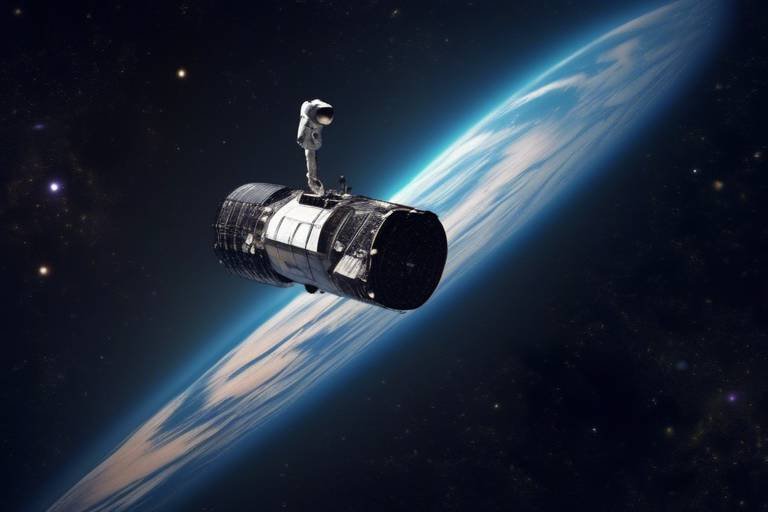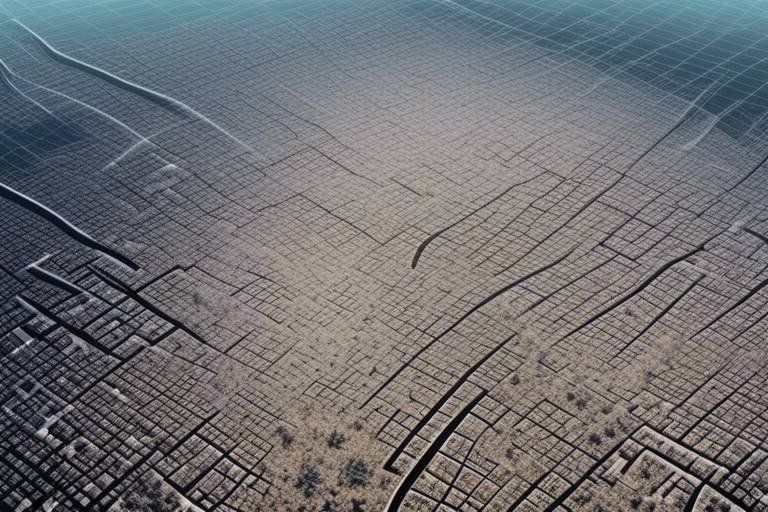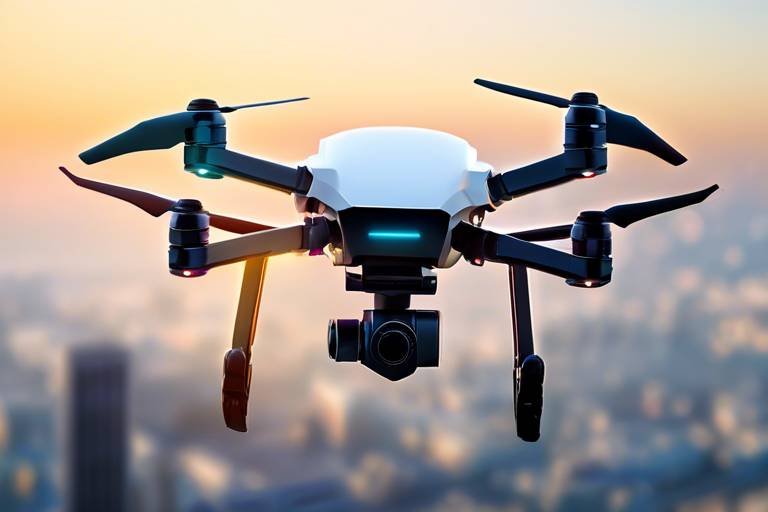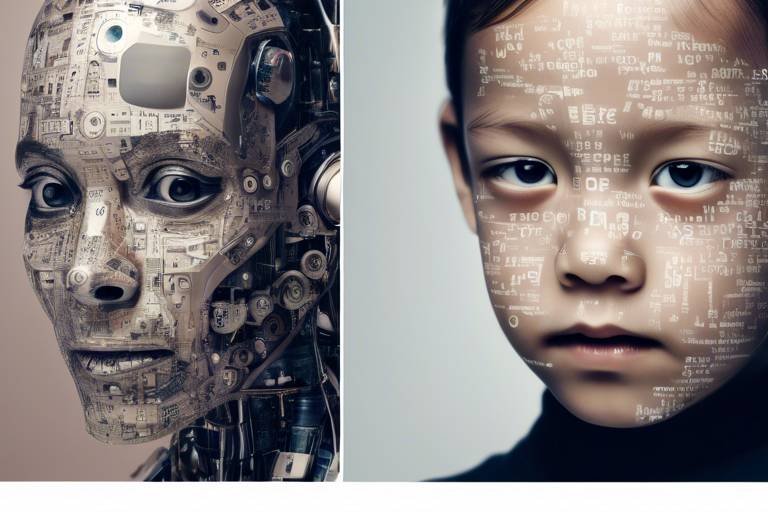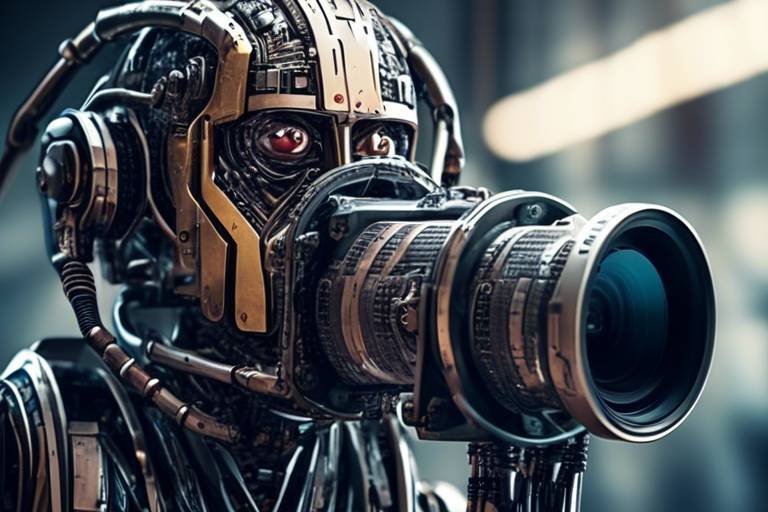Artificial Intelligence in Space Exploration
Welcome to the fascinating world of artificial intelligence (AI) in space exploration! As we stand on the brink of a new era in our quest to understand the universe, AI is proving to be a game-changer. Imagine having a smart assistant that can analyze data faster than any human, make decisions in real-time, and even navigate the vastness of space—all while you sit back and marvel at the stars. Sounds like science fiction, right? Well, it's becoming a reality!
AI technologies are not just enhancing our capabilities; they are transforming the very fabric of how we explore space. From autonomous spacecraft that can chart their own course to sophisticated algorithms that sift through mountains of data, AI is revolutionizing the way we approach space missions. The implications are staggering. With AI, we can explore distant planets, analyze their atmospheres, and even search for signs of extraterrestrial life with unprecedented efficiency.
But what exactly does this mean for the future of space exploration? Picture this: a spacecraft hurtling through the cosmos, equipped with AI that allows it to adapt to unforeseen challenges, make critical decisions, and optimize its mission objectives—all without waiting for instructions from Earth. This level of autonomy not only saves time but also increases the chances of mission success. It's like having a highly trained astronaut onboard, but one that doesn't need to sleep or eat!
In this article, we will delve into the various applications of AI in space exploration, showcasing its benefits and the potential challenges it faces. We'll explore how AI is reshaping mission planning, enhancing data analysis, and even collaborating with human astronauts. With each section, you'll discover how AI is not just a tool but a crucial partner in our journey to uncover the mysteries of the universe.
So, buckle up as we embark on this thrilling adventure into the realm of artificial intelligence and space exploration. It's a journey filled with excitement, innovation, and endless possibilities!
- What is artificial intelligence in space exploration?
AI in space exploration refers to the use of advanced algorithms and machine learning techniques to enhance mission planning, data analysis, and spacecraft operations. - How does AI improve space missions?
AI improves space missions by enabling autonomous decision-making, optimizing data processing, and enhancing the efficiency of operations, allowing for more ambitious exploration goals. - What are some examples of AI in recent space missions?
Recent missions like NASA's Mars Perseverance Rover and ESA's BepiColombo have successfully integrated AI technologies to enhance navigation and data analysis.

The Role of AI in Space Missions
Artificial Intelligence (AI) is not just a buzzword; it's a game-changer in the realm of space exploration. Imagine a world where spacecraft can think on their own, analyze data faster than any human, and make crucial decisions in real-time. This is not science fiction—it's happening right now! AI technologies are becoming integral to space missions, enhancing data analysis, decision-making, and operational efficiency. By automating complex processes, AI allows mission teams to focus on what really matters: unraveling the mysteries of the cosmos.
One of the most significant contributions of AI in space missions is its ability to process and interpret vast amounts of data collected from sensors, telescopes, and other instruments. For instance, during missions to Mars, AI algorithms analyze images and geological data to identify potential sites for exploration. This capability is crucial because the sheer volume of data generated can overwhelm traditional methods of analysis. AI acts like a super-sleuth, sifting through the noise to find the golden nuggets of information that could lead to groundbreaking discoveries.
Moreover, AI enhances mission planning and execution. It can simulate various scenarios, helping scientists and engineers determine the best course of action. For example, if a spacecraft encounters an unexpected obstacle, AI can quickly evaluate alternative routes, assess risks, and suggest optimal solutions. This level of adaptability is essential for missions that operate in unpredictable environments, such as the surface of Mars or the depths of space.
To illustrate the transformative role of AI, consider the following table that outlines some key functions of AI in space missions:
| Function | Description |
|---|---|
| Data Analysis | AI processes large datasets, identifying patterns and anomalies that humans might miss. |
| Navigation | AI enables autonomous navigation, allowing spacecraft to avoid obstacles and reach their targets efficiently. |
| Decision-Making | AI makes real-time decisions based on environmental data, enhancing mission adaptability. |
| Predictive Maintenance | AI predicts potential equipment failures, allowing for proactive maintenance and reducing mission risks. |
In summary, the role of AI in space missions is multifaceted and continually evolving. As we venture further into the universe, the integration of AI will undoubtedly become more sophisticated, leading to more efficient missions and groundbreaking discoveries. The future of space exploration is bright, and AI is at the forefront, guiding humanity as we reach for the stars.
- What is the primary function of AI in space exploration? AI primarily enhances data analysis, decision-making, and operational efficiency in space missions.
- How does AI improve navigation for spacecraft? AI enables autonomous navigation by analyzing environmental data in real-time, allowing spacecraft to avoid obstacles and optimize their paths.
- Can AI help in identifying extraterrestrial life? Yes, AI algorithms can analyze planetary data and detect patterns that may indicate the presence of life.
- What are some challenges of using AI in space missions? Challenges include technical limitations, ethical concerns, and the need for robust systems that can operate in harsh environments.

Autonomous Spacecraft
Imagine a spacecraft zipping through the cosmos, navigating the vastness of space without needing a human hand on the controls. This is not a scene from a science fiction movie; it’s the reality of powered by cutting-edge artificial intelligence (AI). These remarkable machines are revolutionizing space exploration by taking on complex tasks that were once the domain of human operators. With AI at their core, autonomous spacecraft can analyze their surroundings, make decisions in real-time, and even adjust their trajectories without waiting for instructions from Earth.
The development of autonomous spacecraft has opened up a world of possibilities. For instance, consider the challenges of space travel: the distances involved, the time delays in communication, and the unpredictable nature of space environments. Traditional spacecraft relied heavily on ground control for navigation and decision-making, which could lead to delays and missed opportunities. Now, with AI, spacecraft can respond instantly to changing conditions, whether it’s avoiding space debris or adjusting to unexpected solar flares.
One of the key technologies enabling this autonomy is machine learning. By training on vast datasets, AI algorithms can recognize patterns and make predictions about the spacecraft's environment. This capability allows them to perform tasks such as:
- Autonomous navigation: Using sensors and cameras, spacecraft can chart their own course, avoiding obstacles and optimizing their paths.
- Data collection: AI can prioritize which data to collect based on mission objectives, ensuring that the most relevant information is gathered efficiently.
- Self-diagnostics: Autonomous systems can monitor their own health and performance, identifying issues before they become critical.
One standout example of autonomous spacecraft is NASA's Perseverance Rover, which landed on Mars in February 2021. Equipped with advanced AI, Perseverance can navigate the Martian terrain autonomously, allowing it to explore areas that are too risky for human-controlled missions. This capability is crucial for maximizing scientific discovery on Mars, as it can cover more ground and conduct experiments in real-time.
Another fascinating instance is the European Space Agency's (ESA) Hera mission, which aims to study the binary asteroid system Didymos and its moonlet, Dimorphos. Hera will use AI to autonomously analyze the surface of these celestial bodies, gathering data that will help scientists understand their composition and structure. The mission is set to demonstrate how autonomous systems can operate in deep space, paving the way for future exploratory missions.
However, the journey toward fully autonomous spacecraft is not without its challenges. The complexity of space environments means that AI systems must be incredibly robust and capable of handling unexpected situations. Engineers and scientists are continuously working to improve the algorithms that power these spacecraft, ensuring they can make safe and effective decisions in the face of uncertainty.
In conclusion, autonomous spacecraft represent a significant leap forward in our quest to explore the universe. By harnessing the power of AI, these machines are not just tools; they are becoming partners in exploration. As we continue to push the boundaries of what is possible in space, the role of autonomous spacecraft will only grow, leading us to discoveries that were once beyond our reach.
Q: What are autonomous spacecraft?
A: Autonomous spacecraft are vehicles equipped with AI technologies that allow them to navigate and operate independently in space without direct human control.
Q: How do autonomous spacecraft make decisions?
A: They use machine learning algorithms and sensors to analyze their surroundings, recognize patterns, and make real-time decisions based on their programming and learned experiences.
Q: What are some examples of autonomous spacecraft?
A: Notable examples include NASA's Perseverance Rover on Mars and ESA's Hera mission targeting the Didymos asteroid system.
Q: What challenges do autonomous spacecraft face?
A: They must be robust enough to handle the complexities and uncertainties of space environments, requiring ongoing advancements in AI algorithms and technologies.

Data Processing and Analysis
When it comes to space exploration, data is the lifeblood of discovery. Imagine sending a spacecraft millions of miles away, gathering a treasure trove of information about distant planets, stars, and cosmic phenomena. But here’s the kicker: all that data is practically useless unless we can process and analyze it effectively. This is where artificial intelligence (AI) steps in, acting like a supercharged brain that can sift through mountains of data faster than any human could dream. With AI, we’re not just collecting data; we’re turning it into actionable insights that can lead to groundbreaking discoveries.
The sheer volume of data generated by space missions is staggering. For instance, NASA's Mars rovers collect images and scientific measurements at an astonishing rate. To put this in perspective, consider the following statistics:
| Mission | Data Collected (per day) | Data Types |
|---|---|---|
| Curiosity Rover | 1 GB | Images, atmospheric data, soil samples |
| Perseverance Rover | 1.5 GB | Images, audio, rock samples |
| Hubble Space Telescope | 20 GB | Images, spectral data |
With such vast amounts of information, traditional data analysis methods simply fall short. Here’s where AI shines. By employing machine learning algorithms, scientists can automate the process of identifying patterns, anomalies, and correlations within the data. For example, AI can analyze images from Mars rovers to detect signs of past water flow, which is crucial in the search for extraterrestrial life. Instead of manually sifting through thousands of images, AI can quickly highlight the most promising ones, allowing scientists to focus their efforts where it matters most.
Moreover, AI’s ability to learn and adapt means that it can improve over time. As more data is collected, the algorithms become more refined, leading to increasingly accurate analyses. It’s like having a research assistant who never tires and constantly gets smarter! This capability not only speeds up the discovery process but also opens up new avenues for exploration that were previously unimaginable.
However, it’s not just about crunching numbers and analyzing images. AI plays a pivotal role in integrating various data types from multiple sources. For instance, combining data from telescopes, rovers, and satellites can provide a comprehensive view of a celestial body or phenomenon. This holistic approach allows scientists to make more informed decisions and hypotheses about the universe.
In summary, the integration of AI in data processing and analysis is revolutionizing space exploration. By transforming raw data into meaningful insights, AI is not just enhancing our understanding of the cosmos, but also paving the way for future missions that could answer some of humanity's most profound questions. As we continue to push the boundaries of what’s possible in space, the role of AI will undoubtedly become even more critical.
- How does AI help in analyzing data from space missions? AI uses machine learning algorithms to identify patterns and anomalies in vast datasets, allowing scientists to make quicker and more accurate discoveries.
- What types of data do spacecraft collect? Spacecraft collect various types of data, including images, atmospheric measurements, and geological samples, which are crucial for understanding celestial bodies.
- Can AI improve over time? Yes, AI algorithms can learn from new data, becoming more accurate and efficient in their analyses as they process more information.

Robotics in Space
Robotics has emerged as a game-changer in the realm of space exploration, bringing a new level of precision and capability to missions that were once thought to be solely the domain of human astronauts. Imagine sending a robot to a distant planet, equipped with advanced sensors and artificial intelligence, tasked with exploring environments that are too hazardous for humans. This is not science fiction; this is the reality we are stepping into today!
One of the most exciting aspects of robotics in space is the ability of these machines to perform tasks autonomously. For instance, robotic systems can conduct repairs, gather samples, and even analyze data without needing constant human oversight. This independence is crucial when you consider the vast distances involved in space travel. Communication delays can make real-time decision-making impossible, but with AI-driven robotics, spacecraft can respond to their environment and challenges in real time.
Robots like NASA's Perseverance Rover are perfect examples of how this technology is being utilized. Perseverance is not just a rover; it's a sophisticated laboratory on wheels, equipped with a suite of scientific instruments designed to search for signs of past life on Mars. Its robotic arm can drill into the Martian surface and collect rock samples, which it stores for future retrieval. The rover's AI allows it to navigate the rough terrain of Mars autonomously, making decisions about the best paths to take based on its surroundings.
Moreover, robotics in space is not limited to rovers. The International Space Station (ISS) employs robotic arms like the Canadarm2 to assist astronauts in various tasks, from moving cargo to conducting repairs. These robotic systems enhance safety and efficiency, allowing astronauts to focus on more complex tasks that require human ingenuity.
Here’s a quick look at some of the key advancements in robotic technology that are shaping the future of space exploration:
| Robotic System | Functionality | Mission |
|---|---|---|
| Perseverance Rover | Sample collection and analysis | Mars 2020 |
| Canadarm2 | Assists astronauts with cargo and repairs | International Space Station |
| Astrobotic's Peregrine Lander | Delivers payloads to the Moon | Artemis Program |
As we look to the future, the potential for robotics in space exploration is only set to grow. With advancements in AI and machine learning, these robotic systems will become even smarter, allowing for more complex tasks to be performed autonomously. The combination of AI and robotics could lead to the establishment of bases on the Moon or Mars, where robots could prepare the environment for human colonization. The possibilities are as vast as the universe itself!
In conclusion, robotics is not merely an enhancement to space missions; it is a fundamental component that is reshaping how we explore the cosmos. As we continue to push the boundaries of what is possible, the relationship between humans and robots will become increasingly symbiotic, paving the way for a new era of discovery and exploration.
- What are some examples of robotic missions in space?
Some notable missions include NASA's Perseverance Rover on Mars and the Canadarm2 on the International Space Station. - How do robots navigate in space?
Robots use a combination of sensors, cameras, and AI algorithms to analyze their surroundings and make navigation decisions autonomously. - Can robots perform repairs in space?
Yes, robotic systems are designed to perform various tasks, including repairs and maintenance, reducing the need for human intervention.

AI in Planetary Exploration
Artificial Intelligence is not just a buzzword; it’s a game changer in the realm of planetary exploration. Imagine sending a spacecraft to Mars, equipped with the ability to analyze its surroundings and make decisions in real-time. This is not science fiction—it's happening now! AI technologies are playing a pivotal role in enhancing our understanding of other planets and celestial bodies. From analyzing the Martian soil to navigating the treacherous terrains of icy moons, AI is revolutionizing how we explore our solar system.
One of the most exciting applications of AI in planetary exploration is its role in the search for extraterrestrial life. AI algorithms can sift through mountains of data collected by rovers and orbiters to identify patterns that might indicate the presence of life. For instance, NASA's Mars Rover, Perseverance, utilizes AI to autonomously select the most promising sites for sample collection. This capability is crucial because it allows the rover to operate independently, making decisions based on its immediate environment and scientific objectives.
Moreover, AI is instrumental in analyzing planetary environments. Take, for example, the study of exoplanets. AI systems can process data from telescopes, identifying potential habitable zones by analyzing atmospheric compositions. The ability to detect signs of water or organic molecules from light signatures is a breakthrough that could lead us closer to confirming life beyond Earth.
To further illustrate the impact of AI, consider the following table that outlines key missions where AI has been integrated:
| Mission | AI Application | Outcome |
|---|---|---|
| Perseverance Rover | Autonomous navigation and sample selection | Successful identification of rock samples for analysis |
| Europa Clipper | Data analysis for ice and ocean detection | Enhanced understanding of Europa's potential habitability |
| TESS (Transiting Exoplanet Survey Satellite) | Pattern recognition in light curves | Discovery of numerous exoplanets |
As we look to the future, the collaboration between AI and planetary exploration is expected to deepen. AI's ability to learn and adapt means that it can improve its performance over time, leading to even more efficient exploration strategies. However, it’s essential to remain mindful of the ethical implications of using AI in such critical missions. Questions arise about the decision-making processes of AI systems, especially when it comes to prioritizing which areas to explore or what data to analyze first.
In conclusion, the integration of AI in planetary exploration is not just enhancing our capabilities; it’s opening new frontiers of knowledge. As we continue to push the boundaries of what is possible, AI will undoubtedly remain at the forefront, guiding us through the cosmos and helping us answer one of humanity's oldest questions: Are we alone in the universe?
- How does AI help in the search for extraterrestrial life? AI analyzes vast datasets to identify patterns and anomalies that may indicate the presence of life, such as unusual atmospheric compositions.
- What role does AI play in rover missions? AI enables rovers to navigate autonomously, select sample sites, and conduct experiments without direct human intervention.
- Are there any risks associated with using AI in space exploration? Yes, there are ethical concerns regarding decision-making and the potential for AI systems to make critical choices without human oversight.

Challenges and Limitations
As we stand on the brink of a new era in space exploration, the integration of artificial intelligence (AI) brings with it not just opportunities, but also a myriad of challenges and limitations that must be navigated carefully. While AI has the potential to revolutionize the way we explore the cosmos, it is essential to acknowledge the hurdles that could impede its effectiveness. One of the most significant challenges is the technical complexity involved in developing reliable AI systems capable of functioning in the harsh and unpredictable environment of space.
Imagine sending a spacecraft to Mars, where it must make split-second decisions based on its surroundings. The AI algorithms must be robust enough to handle unexpected situations, such as a sudden dust storm or a malfunctioning instrument. However, creating such resilient systems is no easy feat. The intricacies of programming AI to interpret sensory data accurately and respond appropriately in real-time pose a daunting challenge for engineers and scientists alike.
Furthermore, the ethical implications of deploying AI in space cannot be overlooked. As AI systems take on more autonomous roles, questions arise about accountability. Who is responsible if an AI-operated spacecraft makes a critical error? Is it the engineers who designed the AI, the mission planners, or the AI itself? These questions are not just theoretical; they require serious consideration as we advance toward more autonomous missions.
Another limitation lies in the data dependency of AI technologies. AI thrives on data—lots of it. In space exploration, however, obtaining sufficient and high-quality data can be a significant hurdle. For instance, if a spacecraft is exploring a distant planet, the amount of data it can collect is limited by its instruments and the time it spends in that environment. This limitation can hinder the AI's ability to learn and adapt, ultimately affecting mission outcomes.
Moreover, the operational challenges of implementing AI in space missions are substantial. Spacecraft must operate in environments with delayed communication, especially when venturing beyond the Moon. This latency can complicate the AI's decision-making process, as it may not receive timely updates or instructions from mission control. In such scenarios, the AI must rely on pre-programmed responses and its learning from past experiences, which may not always be sufficient.
In summary, while the potential for AI in space exploration is vast, these challenges and limitations must be addressed through ongoing research, collaboration, and ethical considerations. As we look to the stars, it is crucial to ensure that our technological advancements do not outpace our understanding of their implications. Only then can we truly harness the power of AI to unlock the mysteries of the universe.
- What are the primary challenges of using AI in space exploration? The main challenges include technical complexity, ethical implications, data dependency, and operational challenges.
- How does AI help in decision-making for spacecraft? AI analyzes data in real-time, enabling spacecraft to make informed decisions based on their surroundings.
- What ethical concerns arise with autonomous AI in space? Accountability for errors made by AI systems and the potential for bias in decision-making are significant ethical concerns.

Future Prospects of AI in Space
The future of artificial intelligence (AI) in space exploration is not just bright; it's dazzling! As we stand on the brink of a new era in space travel, the integration of AI technologies is expected to revolutionize how we explore the cosmos. Imagine a world where spacecraft can autonomously navigate through the treacherous terrains of distant planets, or where AI systems analyze data in real-time to make instant decisions that could lead to groundbreaking discoveries. This isn't science fiction; it's the future we're heading towards.
One of the most exciting prospects is the development of smart spacecraft. These vessels will be equipped with advanced AI algorithms that allow them to learn from their environments and adapt their missions accordingly. For instance, future missions to Mars may utilize AI to assess weather patterns, geological conditions, and even potential hazards, ensuring that astronauts and robotic explorers can make informed decisions. The ability to process vast amounts of data instantaneously will not only enhance mission safety but will also allow for more ambitious exploration plans.
Furthermore, as we look beyond our own planet, the role of AI in searching for extraterrestrial life is becoming increasingly critical. AI can analyze the chemical compositions of atmospheres, identify potential biosignatures, and even assist in the design of experiments to test for life on other planets. This capability could lead to significant breakthroughs in our understanding of life beyond Earth, making the quest for extraterrestrial organisms a more attainable goal.
Moreover, the collaboration between AI and human astronauts is set to evolve. Imagine astronauts on long-duration missions, like those to Mars, being supported by AI systems that not only assist with daily tasks but also provide real-time health monitoring and psychological support. This synergy will enhance the overall mission success rate and ensure that humans can thrive in the challenging environments of space.
However, the journey into the future is not without its challenges. As we push the boundaries of AI in space, we must address crucial ethical considerations, such as decision-making in life-and-death situations. The potential for AI systems to malfunction or make incorrect decisions raises questions about accountability and reliability. Therefore, ongoing research and development must focus on creating robust, fail-safe systems that can be trusted in critical missions.
In summary, the prospects of AI in space exploration are not just about enhancing our current capabilities; they represent a paradigm shift in how we approach the universe. As we continue to innovate and integrate these technologies, the possibilities are endless. We are on the verge of discovering new worlds, unlocking the mysteries of the universe, and perhaps even finding our cosmic neighbors—all thanks to the transformative power of artificial intelligence.
- What are the advantages of using AI in space exploration? AI enhances data analysis, improves decision-making, and increases operational efficiency, making missions safer and more effective.
- How does AI assist in planetary exploration? AI helps analyze planetary environments, search for extraterrestrial life, and optimize mission planning and execution.
- What challenges does AI face in space? Technical limitations, ethical concerns, and the need for reliable systems are significant challenges that must be addressed.
- Can AI operate spacecraft autonomously? Yes, AI can enable spacecraft to navigate and make decisions independently, reducing the need for constant human oversight.

Collaboration Between AI and Human Astronauts
The collaboration between artificial intelligence (AI) and human astronauts is nothing short of revolutionary. Imagine embarking on a journey to the stars, where your trusty AI companion is not just a tool, but a co-pilot, enhancing your capabilities and ensuring mission success. This partnership is reshaping how we explore the cosmos, allowing astronauts to focus on critical tasks while AI handles the heavy lifting. But what does this collaboration look like in practice?
AI systems are designed to assist astronauts in various ways, from monitoring spacecraft systems to providing real-time data analysis. For instance, AI can analyze environmental conditions, identify potential hazards, and suggest optimal strategies for navigation and operation. This is particularly crucial in scenarios where human decision-making is limited by time or complexity. With AI taking care of routine tasks, astronauts can dedicate their mental resources to more complex problem-solving and creative thinking.
One of the most exciting aspects of this collaboration is the ability of AI to learn and adapt. As astronauts engage in their missions, AI systems can gather data on their preferences, habits, and decision-making processes. This information can be used to tailor AI responses, making it a more effective partner. For example, if an astronaut prefers a specific method for conducting experiments, the AI can adjust its recommendations accordingly, fostering a more intuitive working relationship.
Moreover, the synergy between AI and human astronauts can lead to improved safety. In high-stakes environments, such as space missions, the ability to predict and mitigate risks is invaluable. AI can analyze vast amounts of data from previous missions to identify patterns and potential issues, alerting astronauts before they become critical problems. This proactive approach not only enhances safety but also boosts the confidence of astronauts as they navigate the unknown.
However, it's essential to recognize that this collaboration is not without its challenges. Trust is a significant factor; astronauts must be able to rely on AI systems, knowing that they will function correctly in high-pressure situations. Additionally, there are ethical considerations regarding the level of autonomy granted to AI. Striking the right balance between human oversight and AI decision-making is crucial for mission integrity.
In summary, the collaboration between AI and human astronauts represents a new frontier in space exploration. As we continue to push the boundaries of what is possible, this partnership will likely evolve, leading to even more sophisticated systems that enhance our capabilities in the cosmos. Just as a skilled navigator relies on their instruments, astronauts of the future will depend on AI as an indispensable ally in their quest to explore the final frontier.
- How does AI assist astronauts during missions?
AI helps by monitoring spacecraft systems, analyzing data, and providing recommendations, allowing astronauts to focus on critical tasks. - What are the benefits of AI collaboration in space exploration?
The collaboration enhances safety, improves efficiency, and allows for more complex problem-solving. - Are there risks associated with AI in space missions?
Yes, trust and ethical considerations regarding AI autonomy are significant challenges that need to be addressed.

Case Studies of AI in Recent Missions
Artificial Intelligence has been a game-changer in the realm of space exploration, and several recent missions have showcased its remarkable capabilities. One standout example is NASA's Perseverance rover, which landed on Mars in February 2021. This rover is equipped with advanced AI systems that allow it to navigate the Martian terrain autonomously. Imagine a robot exploring a vast, dusty landscape, making decisions on the fly, and avoiding obstacles without human intervention—this is exactly what Perseverance does. It uses a sophisticated onboard AI called Terrain Relative Navigation to analyze its surroundings and make real-time decisions about its path. This ability not only enhances the efficiency of the mission but also minimizes risks associated with human-operated controls.
Another fascinating case study is the European Space Agency's (ESA) Rosetta mission, which successfully orbited and landed on a comet in 2014. The mission's success was largely due to the use of AI in data analysis and decision-making processes. Rosetta's AI systems processed an immense amount of data collected from the comet's surface and atmosphere, enabling scientists to gain insights into the origins of our solar system. By applying machine learning algorithms, the mission team could quickly identify patterns and anomalies in the data, which led to groundbreaking discoveries about the comet's composition.
Moreover, the Autonomous Sciencecraft Experiment (ASE) aboard NASA's Earth Observing-1 (EO-1) satellite demonstrated how AI can drive autonomous scientific decision-making in space. This experiment allowed the spacecraft to identify and prioritize areas of interest on Earth, such as natural disasters or environmental changes, without waiting for instructions from ground control. The AI system on EO-1 processed images and made decisions about which areas needed further observation, showcasing a leap towards more autonomous missions that can respond to urgent situations in real-time.
In addition to these missions, AI is also making waves in the realm of satellite operations. For instance, the SkySat satellites developed by Planet Labs utilize AI for image processing and analysis. These satellites capture high-resolution images of the Earth, and AI algorithms help in sorting through the vast amounts of data to identify changes in land use, urban development, and environmental impacts. This not only aids researchers but also provides valuable information for governments and organizations working on climate change and resource management.
The integration of AI into these missions illustrates its profound impact on the future of space exploration. By enhancing autonomous operations, improving data analysis, and enabling real-time decision-making, AI is paving the way for more ambitious missions that can explore further and deeper into the cosmos. As we look to the future, the potential for AI to transform our understanding of the universe is limited only by our imagination and technological advancements.
- How does AI enhance the efficiency of space missions?
AI helps in automating tasks, enabling real-time decision-making, and processing vast amounts of data quickly, which leads to more efficient mission operations. - What are some challenges faced when integrating AI in space exploration?
Challenges include technical limitations, ethical considerations, and the need for robust systems that can operate in extreme environments. - Can AI help in the search for extraterrestrial life?
Yes, AI can analyze data from planetary missions to identify potential signs of life by detecting patterns that humans might overlook.
Frequently Asked Questions
- What is the role of AI in space exploration?
AI plays a transformative role in space exploration by enhancing data analysis, decision-making, and operational efficiency. It helps in mission planning and execution, allowing for more effective use of resources and time during space missions.
- How do autonomous spacecraft utilize AI?
Autonomous spacecraft are equipped with AI technologies that enable them to operate independently. This means they can navigate complex environments, make real-time decisions, and adapt to unforeseen challenges without needing constant human intervention.
- What are the benefits of using AI for data processing in space?
AI significantly enhances data processing capabilities by employing machine learning algorithms to analyze vast amounts of data collected from space missions. This leads to quicker insights, improved accuracy, and the potential for groundbreaking discoveries in our understanding of the universe.
- How is robotics integrated with AI in space missions?
Robotic systems powered by AI are crucial for various tasks in space exploration, such as maintenance, exploration, and sample collection. These advanced robots can perform complex operations, often in environments that are hazardous for human astronauts.
- Can AI help in the search for extraterrestrial life?
Absolutely! AI is instrumental in planetary exploration, analyzing data from missions targeting Mars and other celestial bodies. It aids scientists in identifying signs of life and understanding planetary environments, making it a key player in the search for extraterrestrial life.
- What challenges does AI face in space exploration?
Despite its many advantages, the integration of AI in space exploration comes with challenges. These include technical limitations, ethical concerns, and operational hurdles that need to be addressed to ensure successful AI implementation in future missions.
- What does the future hold for AI in space exploration?
The future of AI in space exploration looks promising, with ongoing research and development paving the way for new innovations. These advancements could significantly impact future missions and lead to exciting discoveries that expand our understanding of the universe.
- How does AI collaborate with human astronauts?
The synergy between AI and human astronauts is vital for mission success. AI can assist astronauts by enhancing their capabilities, providing real-time data analysis, and improving decision-making processes, ultimately leading to better mission outcomes.
- Can you provide examples of AI in recent space missions?
Yes! Several recent space missions have successfully integrated AI technologies. These case studies illustrate the practical applications and benefits of AI, showcasing how it has enhanced mission efficiency and contributed to significant findings in space exploration.

